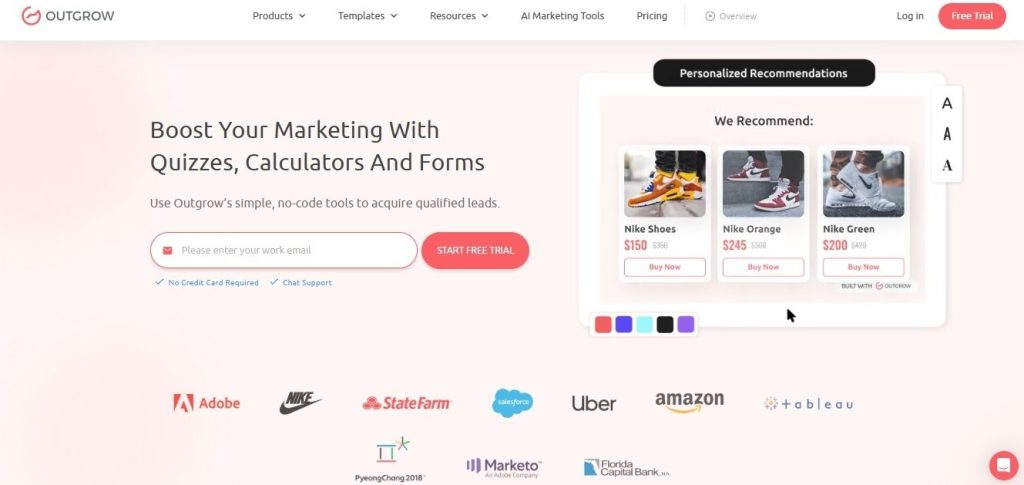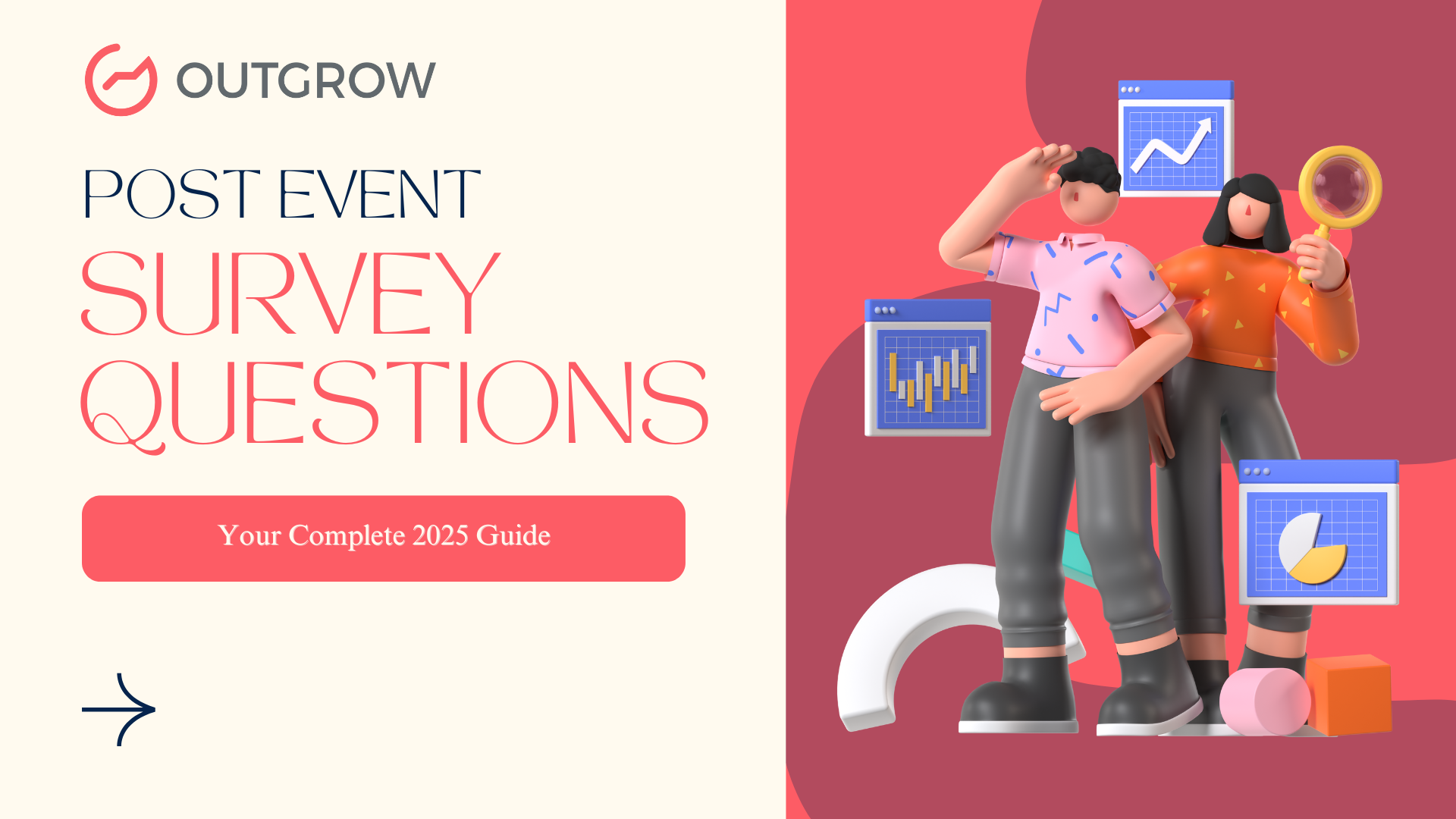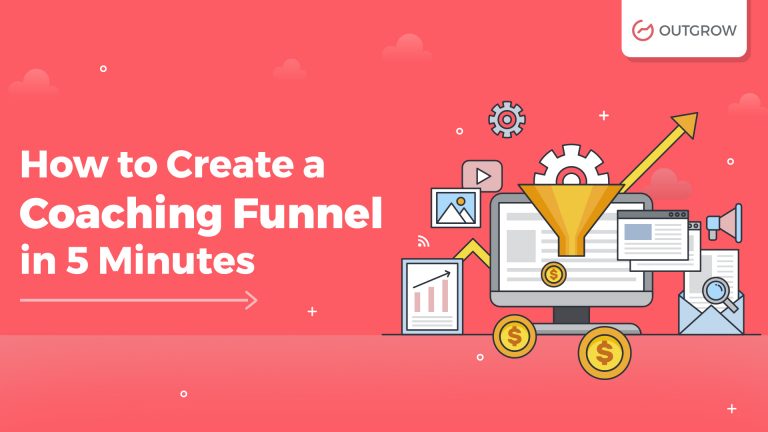Introduction
Table of Contents
So you just wrapped up an event. Weeks of planning, thousands of dollars, countless sleepless nights. And now you’re sitting there wondering… what next?
Here’s what most event planners do: either skip the feedback part entirely, or fire off some boring survey that nobody wants to finish. The stats? The average response rate sits at a painful 10%. Ninety percent of your attendees basically disappear right when you need them most.
It doesn’t have to suck this much. People can actually want to complete your surveys using post-event survey questions – and I’m going to show you exactly how.
Why Post-Event Survey Questions Matter (And I Mean Really Matter)
Think about planning your next conference based purely on hunches and gut feelings. You’re basically driving blindfolded down the highway.
Post-event survey questions show you what worked, what bombed hard, and what people are dying to see next time. Ahrefs ran its Evolve 2024 conference in Singapore, with 500 attendees. They sent three surveys: attendees, employees, and sponsors. The feedback they got? Shaped their entire plan for Evolve 2025.

Why you absolutely cannot skip this:
- Stop wasting money: Maybe you spent five grand on fancy swag when people actually wanted more networking time. Your survey, made using Free Survey Maker, will tell you this stuff.
- Build real relationships: People see you asking for opinions, then making changes based on what they said – they feel heard. Builds loyalty faster than any marketing campaign ever could.
- Make decisions with actual data: Should next year’s event be hybrid? Need a bigger venue? Different timing? Survey data gives you answers instead of guesses.
- Find your promoters: Net Promoter Score helps identify your biggest fans – the ones already telling everyone about your event.
SurveyMonkey data puts the average NPS across industries at 32. Above 30 means you’re doing well. Above 70? You’re killing it.
The Employee Survey Most Organizers Forget
Before diving into attendee surveys, there’s something most people completely overlook: your team’s experience.
Staff and volunteers are on the front lines. They see stuff you don’t. Hear complaints you miss. Spot problems you’re blind to.
Employee satisfaction surveys for events? Just as critical as attendee surveys.

Ask your team about:
- Workload balance (did someone drown while others stood around?)
- Communication clarity (does everyone know their actual role?)
- How fast they could solve problems
- Whether they had what they needed
- Stress levels and where things got chaotic
One events company discovered through employee surveys that check-in took twice as long as planned. Created bottlenecks, stressed everyone. They redesigned the whole system – next event, check-in time got cut in half.
Send team surveys within 24 hours. Keep it short – ten questions max. Anonymous surveys get honest answers.
The Perfect Survey Structure
Most surveys fail right here: too long, boring, or vague as hell.

You need a balance between useful data and respecting people’s time. Sweet spot? Ten to twelve questions, takes three to five minutes.
Start With the Big Picture
The opening question grabs overall satisfaction. Simple 1-10 rating scale works:
“How would you rate your overall experience at [Event Name]?”
Gives you baseline metrics to track year over year. Satisfaction drops from 8.5 to 7.2? Something went wrong.
Get Specific
Now drill into what makes or breaks events:
- “How valuable was the content?”
- “Which speaker gave you the most value, and why?”
- “Rate the venue and facilities.”
- “Rate networking opportunities 1-10.”
- “Food and refreshments – how’d we do?”
See the mix? Some use rating scales for easy analysis. Others stay open-ended to capture nuanced feedback that numbers can’t give you.
Measure Loyalty
This separates casual attendees from die-hard fans:
- “How likely are you to attend our next event?” (1-10)
- “How likely to recommend this event to a colleague?” (Your NPS question)
These two questions predict your event’s future better than almost anything. NPS between 30-70 means solid ground. Below zero? Serious work ahead.
Get Actionable Stuff
End with questions giving specific direction:
- “What was your favorite part?”
- “What could we improve?”
- “Topics or speakers you want for future events?”
- “Anything else to share?”
Open-ended questions contain gold. Someone mentions a scheduling conflict you missed. Another suggests a format change that becomes your next breakthrough.
Interactive Content Changes the Game
Traditional surveys are boring. People see them as homework, not opportunities to help.
Interactive content flips this completely.
Why Outgrow Beats Traditional Tools

Platforms like Outgrow create survey experiences that feel like conversations, not interrogations. Instead of staring at bland forms, people interact with engaging visual stuff.
The difference is huge. Traditional online survey tools get 10% response rates. Interactive surveys? Companies see 40%+ completion rates.
Why Outgrow works:
- Visual engagement keeps attention. Dynamic layouts, progress bars, intuitive designs – surveys actually feel good. People see they’re halfway through instead of wondering how many pages remain, so they finish.
- Smart logic creates personal experiences. Not every question fits everyone. Outgrow’s branching logic shows different questions based on previous answers. Someone rating networking 2/10 gets asked, “What networking format would you prefer?” Someone rating 9/10 doesn’t see that.
- Real-time results build excitement. Attendees see how their answers compare to others instantly. “78% rated the keynote excellent – you’re in good company!” Makes surveys feel less like chores, more like community participation.
- Mobile optimization is automatic. Over 60% check emails on phones. Survey looks broken on mobile? You lost half your respondents. Outgrow optimizes everything automatically for any device.
- Integration saves hours. Nobody wants to manually copy data into spreadsheets. Outgrow connects with 1,000+ tools – your CRM, email platform, analytics dashboard. Set it once, and data flows automatically.
Building With Outgrow
The process is straightforward. Start with their 1,000+ templates designed for events, conferences, webinars, and trade shows. Customize questions for your event. Adjust colors and fonts for your brand. Set up logic branches. Publish.
Embed directly on your website, send via email, or pop up as chat. Flexibility means meeting attendees where they are.
Bonus: Outgrow’s analytics shows exactly where people drop off. Eighty percent abandon at question seven? You know that question needs fixing.
Questions You Can Use Right Now
Stop starting from scratch. Battle-tested questions by category:
- Overall Experience: Rate overall experience 1-10. Did the event meet expectations? Three words to describe this event? What was the highlight?
- Content: How relevant was the content to your needs? Which session is most valuable? Topics you wished we covered? Rate speaker quality 1-10. Duration appropriate?
- Logistics: How was registration and check-in? Rate venue location 1-10. Facilities comfortable? Rate food and beverages.
- Networking: Enough opportunities to network? Rate networking quality 1-10. Make valuable connections? What networking format worked best?
- Virtual Events: Platform quality? Technical difficulties? Easy to access sessions? Feel engaged?
- Future Planning: How likely to attend the next event? How likely to recommend? Preferred format for future? Best time of year?
- Open Feedback: What should we keep? What should we change? What would make you more likely to attend next time? Other comments?
- Mix and match based on your event type. Two-hour webinar needs fewer questions than a three-day conference.
Getting More People to Respond
Even great surveys fail if nobody fills them out. How to maximize responses:
- Timing matters. Send surveys within 24 hours of the event ending. Wait longer than 48 hours, and response rates drop by half. People forget details, lose interest, and get busy. For multi-day conferences, consider brief daily pulse surveys (three questions) each evening, a comprehensive survey at the end.
- Incentivize smartly. Offering incentives boosts responses 30-50%. Try early bird discounts for next year, raffle for prizes, exclusive access to session recordings, and charitable donations in respondents’ names.
- Best incentives tie back to your event or audience interests. Tech conferences might raffle the latest gadgets. Sustainability summits plant trees for each completed survey.
- Mobile first. Over 60% of surveys are opened on mobile. Doesn’t look good on phones? You lost most of your audience.
- Test on multiple devices before sending. Short questions, large buttons, simple layouts. Typing long responses on phone keyboards is painful – save open-ended questions for the end.
- Show what you did with last year’s feedback. Start surveys with: “Last year you asked for better networking, so we added structured meetups. What should we improve this year?”
- Proves you listen and implement suggestions. People respond more when they see that feedback creates real change.
Turning Data Into Action
Collecting responses is half the battle. Now make sense of what you’ve got.

- Start with rating scale questions: Calculate average scores, response distribution, year-over-year trends, and segment analysis. Look for patterns. Eighty percent rated the venue 9-10, but only 40% rated networking that high? You know exactly where to focus improvement. For open-ended responses, read through every single one. Look for themes repeating across multiple respondents.
- Create categories: content feedback, logistical issues, venue comments, networking experiences, suggestions for improvement. Five people independently mentioned that lunch lines were too long. Not a coincidence – a real problem to fix.
- Use word cloud tools to visualize common terms: “Engaging,” “practical,” “actionable.” Show up frequently in positive feedback? Those are your marketing messages for next year.
- Don’t let survey data sit in spreadsheets: Create an action plan with quick wins you can fix immediately and strategic changes needing planning. Share findings with your team, sponsors, and attendees. Send follow-up emails: “Here’s what you told us and what we’re doing about it.”
Wrapping Up
Running events is hard enough without flying blind. Post-event survey questions give you intelligence to make smart decisions, build loyalty, and grow events year after year.
Difference between events that plateau and events that keep getting better? Consistent feedback loops.
Stop treating surveys as afterthoughts you slap together before hitting send. Invest time crafting questions that matter. Choose tools like Outgrow, making responding enjoyable. Analyze data seriously. Take action on what you learn.
Do this right, and attendees will line up for your next event before you announce it. When people feel heard and see feedback creating change, they don’t just come back – they bring friends.
FAQs Regarding Post-Event Survey Inquiries
Rating scales and open-ended questions make up the best post-event survey questions. Start by asking, “Rate your overall experience” (1–10). Next, inquire about the venue, presenters, networking, logistics, and quality of the content. “How likely to recommend this event?” should be included. “What should we improve?” concludes. Ten to twelve questions about satisfaction, particular components, and future intent make up a good survey.
Traditional surveys = homework nobody wants to do. Interactive quiz software like Outgrow = actual conversation with progress bars and visual stuff people enjoy. The branching logic shows different questions based on what you answered before. Companies jump from 10% to 40%+ completion just by switching.
10-12 questions tops. That’s about 3-5 minutes. Go longer than 15 questions, and people bail. Mix it up: 3-4 rating scales for the numbers, 2-3 multiple choice for specifics, 3-4 open-ended for the good stuff. Virtual events can be shorter – 8-10 questions.
Within 24 hours – better yet, within 12. Wait 48+ hours, and you lose half your responses because people forget or move on. Multi-day conferences? Send quick 3-question checks each night, big survey on the last day. Remind non-responders after 2 days, then again at 5 days.
NPS asks “How likely would you recommend this?” on a 0-10 scale. People saying 9-10 are your superfans (promoters). 7-8 are fine but not excited (passives). 0-6 are unhappy (detractors). Subtract detractor % from promoter %. SurveyMonkey says 32 is average. Above 70? You’re crushing it. Below 0? Fix stuff fast.

Muskan is a Marketing Analyst at Outgrow. She is working on multiple areas of marketing. On her days off though, she loves exploring new cafes, drinking coffee, and catching up with friends.






